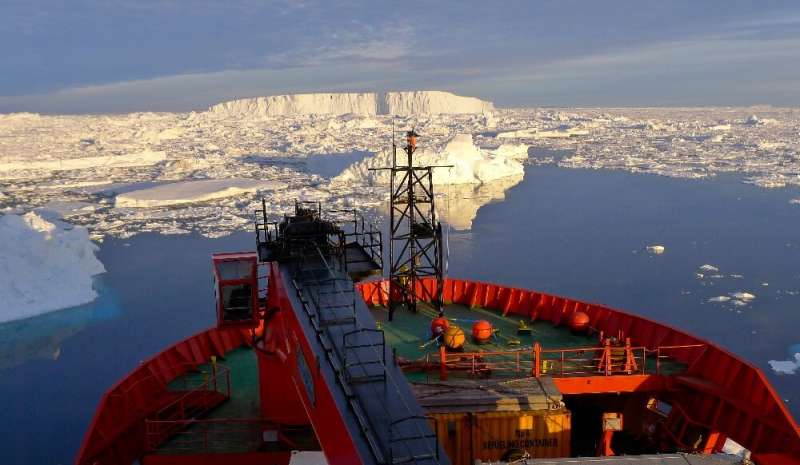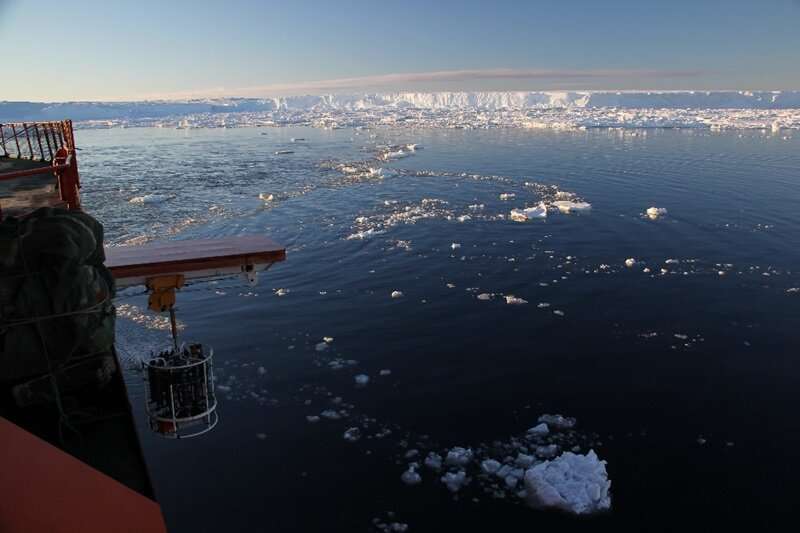This article has been reviewed according to Science X's editorial process and policies. Editors have highlighted the following attributes while ensuring the content's credibility:
fact-checked
peer-reviewed publication
trusted source
proofread
Earth's deep ocean oxygen levels are declining, shows study

Antarctica is a unique landscape, full of mystery and wonder. Its environments have a huge impact on the rest of the planet—on the climate, the ocean and on life itself.
About 250 trillion metric tons of salty, oxygen-rich, and dense water sinks near Antarctica each year. This is known as Antarctic Bottom Water (AABW). The process of sinking drives a global network of currents. Newly formed AABW fills up to 40% of the total volume of the world's ocean. Much like the way a lung pumps oxygen into our blood, AABW transports oxygen—as well as carbon and nutrients—into the deep Indian, Pacific and Atlantic Oceans.
But a new study led by CSIRO researcher Dr. Kathy Gunn, shows this sinking of dense water has slowed. And, with this, deep ocean oxygen levels have also declined. The research is published in the journal Nature Climate Change.
"Our observations show the deep ocean circulation around Antarctica has slowed overall by about 30% since the 1990s. This slowdown locks in decades of impacts," Kathy said.
This slowdown happened because increased melting of Antarctica's glaciers made surface waters less salty, and therefore more buoyant. This means there is less dense water sinking from the surface to the depths. The interruption of a key process that replenishes the deep ocean with oxygen has effects that reach far beyond the immediate sea.
What changes can we expect?
The results of the study show the deep ocean circulation is declining at a rate that models predicted wouldn't happen until about 2050.
Professor Matthew England, co-author and Deputy Director of the Australian Center for Excellence in Antarctic Science, said recent modeling suggested that under the IPCC high emissions scenario the flow of AABW would slow by more than 40% by 2050.
"But these latest observations suggest the projected slowdown is in fact already well underway," Matthew said.
And, as this circulation slows down, the bottom of the oceans start to stagnate.
"This would trap nutrients in the deep ocean, reducing the nutrients available to support marine life near the ocean surface," he said.
Co-author Dr. Steve Rintoul, from our Australian Antarctic Program Partnership, said there are further impacts.
"We're used to the idea that melting of the Antarctic Ice Sheet causes sea level rise. But this work also shows us that the impacts of melting glaciers in Antarctica extend all the way to the deep sea, affecting climate and ocean chemistry, as well as sea level," Steve said.
Measuring the mysterious Southern Ocean
Not much is known about the Southern or Antarctic Oceans compared to other oceans. However, the oceans buffer the worst impacts of climate change by absorbing at least 90% of the excess heat trapped in Earth's atmosphere.
Kathy and her team have now developed a new method of measuring the deep circulation in the Southern Ocean. From this, they have achieved the first observation-based estimates of how the volume transport of AABW has changed.
"AABW is formed close to Antarctica, so one of the only ways to get there and directly observe its changes is by ship," Kathy said.
She said repeated full-depth measurements from ships are the gold standard of data acquisition for the deep seas. But these measurements have only been repeated about once every 10 years since the 1970s.
"And because the bottom water is so deep, it's very hard to measure by other means," Kathy said. "We are talking depths of up to 6,000 meters. The data that we regularly collect goes only to 2,000 meters."
This means data on the deep Southern Ocean is scarce. But researchers still noticed volumes of AABW were getting smaller.
"The ship measurements showed us that the bottom water layer was shrinking at several locations," Kathy said.
"But we didn't know exactly what was causing it."

So how did they do it?
To discover how and why the deep ocean was changing, the team combined the ship observations with water speed, temperature and salinity measurements from moored instruments. The moorings were attached to wires anchored to the seabed, with floats at the top, and left for up to two years at a time. Using models to fill any data gaps, the researchers could then calculate the volume and oxygen transport of the AABW.
Co-author Dr. Melissa Bowen from the University of Auckland said the novelty of the method is combining a variety of observational data with realistic model simulations.
"The data is limited in space, but it shows us what is really happening in the ocean," Melissa said.
"The simulation, on the other hand, is not able to reproduce the real ocean exactly, but it can tell us about the nature of the ocean currents where measurements were not available.
"By combining what the flow looks like in space from the simulation with the changes in time from the moorings, we use the best information from both," she said.
The team focused on the Australian Antarctic Basin, because it has historically shown large changes in AABW, and is most likely to provide an emergent "early-warning" sign.
Melissa said the mooring location within the Australian Antarctic Basin is at its gateway with the Ross Sea.
"Here we can see dense water pulsing with the tides and fluctuating as its density changes,"Melissa said.
She said the method they've developed can continue to provide estimates of AABW.
Where to now?
The freshening around Antarctica is expected to continue, even accelerate, as the Antarctic Ice Sheet responds to and melts under a rapidly warming climate. But it's not all bad news.
"We also found an increase in shelf water salinity between 2009 and 2018, which drove a partial recovery," Kathy said.
She says this recovery provides further motivation to continue to work hard in reducing global carbon emissions.
"It's all to do with salinity. The salinification and recovery of the circulation shows that the mechanisms can work in both directions," she said.
"So, if freshening reduces, then some of the deep overturning circulation could be recovered."
But, for now, the overall decline is already changing the deep ocean's structure and chemistry.
"The slowdown means we are already committed to a certain amount of change that will play out across the next few decades," Kathy said.
More information: Kathryn L. Gunn et al, Recent reduced abyssal overturning and ventilation in the Australian Antarctic Basin, Nature Climate Change (2023). DOI: 10.1038/s41558-023-01667-8
Journal information: Nature Climate Change
Provided by CSIRO




















